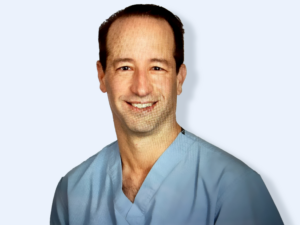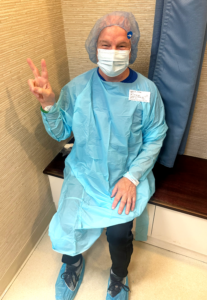 Retiree Bruce Barkhorn frequently fishes for striped bass off the coast of Keyport, New Jersey.
Retiree Bruce Barkhorn frequently fishes for striped bass off the coast of Keyport, New Jersey.
The 75-year-old angler spends hours each spring and fall navigating the waterway to reel in the perfect prize catch.
“Stripers, we call them,” he smiled. “It’s a good-eating fish. They’re big. It’s a lot of fun catching them. They’re really good sport fishing. It’s very popular here in New Jersey.”
Barkhorn’s passion for his maritime hobby faced a setback when cataracts began impairing his vision. Driving from his inland home to his boat on Raritan Bay became increasingly difficult, especially at night.
“[My vision] was out of focus a lot, and it got pretty bad the last year and a half,” he said. “My boat is about 30 miles away from where I live. I’d get on a parkway, and it was a little disconcerting driving. So, I knew I needed surgery sooner [rather] than later.”
What are Cataracts?
Cataracts are the leading cause of preventable blindness worldwide. They develop when proteins accumulate in the eye’s lens, making vision blurry, hazy or cloudy.

“Everyone gets cataracts eventually,” Dr. Klein said. “Many times, they’ll start off as not being that visually significant. Over a couple of years, the vision will continue to degrade, and eventually, patients will come in complaining of blurred vision. And many times, there’s nighttime symptoms such as glare or halos, especially driving the car.”
Surgery is the only treatment option to medically remove a cataract. Vision impairment or blindness may result from untreated cataracts, so it is important not to delay surgery too long. In the U.S., surgeons perform nearly four million cataract surgeries every year.
“When we do cataract surgery, there’s always two parts of the surgery. The first part is taking out the lens of the eye that’s become cloudy. That’s called a cataract,” Dr. Klein said. “The second part is putting a new [intraocular] lens in the eye. If you don’t have a lens in your eye, you can’t focus the light that’s coming in. You can’t see.”
An intraocular lens (IOL) is made from materials like silicone or acrylic. IOLs often have a protective coating to block UV rays. Various IOLs are available to accommodate different vision needs and lifestyles. Some lenses may reduce your dependence on glasses.
After five decades wearing glasses, Barkhorn did not want to wear prescription eyewear post-procedure. He selected a multifocal lens designed to correct his astigmatism and give him distance and near vision.
Choose an ASC for Cataract Surgery
More than 50 percent of Americans aged 80 or older either have cataracts or have had surgery to remove them. Cataract surgery is a safe procedure to restore your vision and enhance your quality of life.

“The truth is that the procedure, when we do it, takes about six or seven minutes,” Dr. Klein said. “There’s no pain. People are comfortable. It’s not a hardship to go through. The recovery is not hard to go through.”
Following surgery, Barkhorn wore a patch over his eye the first night and applied eye drops four times a day for a week. His full vision was restored within a few days.
Two weeks later, he returned to River Drive and the cataract was removed successfully from Barkhorn’s right eye. Based on his experiences, Barkhorn said he would recommend cataract surgery at an ASC.
“At my age, I’ve had a couple operations, and to me they [were] as professional as you’re going to get,” he said. “It’s almost like going to a major hospital in New York City. I was really shocked at how good it was!”
AMSURG-affiliated ambulatory surgery centers (ASCs), like River Drive, are typically able to perform cataract procedures at the same high level and quality of care at a lower cost. ASCs offer additional advantages for patients:
- They can focus on specific procedures, not emergencies or trauma, so your appointment is less likely to be affected.
- They are easily navigable and usually have convenient parking because many ASCs are smaller than other healthcare facilities.
- They offer more cost-effective procedures than other facilities.
Since his successful cataract surgery, Barkhorn now drives confidently to the New Jersey shore for striper fishing.
“I get up in the morning — I don’t have to reach for my glasses anymore. That’s all gone now,” he said. “One of the side benefits is I can choose any kind of sunglasses I want. Before, I was restricted to prescription [sunglasses]. Now, I can go to the store and buy them.”
Dr. Klein said patients benefit from having cataract surgery in an outpatient setting.
“Even though the surgery is delicate and can be complicated, our surgical teams are proficient with excellent results,” he said. “There’s a very high volume of surgeries to be done, and we can take care of them efficiently and in a comfortable manner for the patients.”
Find an Ophthalmologist Near You
A comprehensive eye exam is a key part of preventive care. Exams help detect common eye diseases such as cataracts, glaucoma and age-related macular degeneration. A board-certified ophthalmologist can assess your vision health and recommend any necessary treatments or surgeries. Protect your eyesight. Find a nearby eye center and schedule an appointment today.
This article is designed for educational purposes only. The information provided should not be used for diagnosing or treating a health concern or disease. It is not a substitute for professional care. If you have or suspect you may have a health concern, you should consult your healthcare provider.
